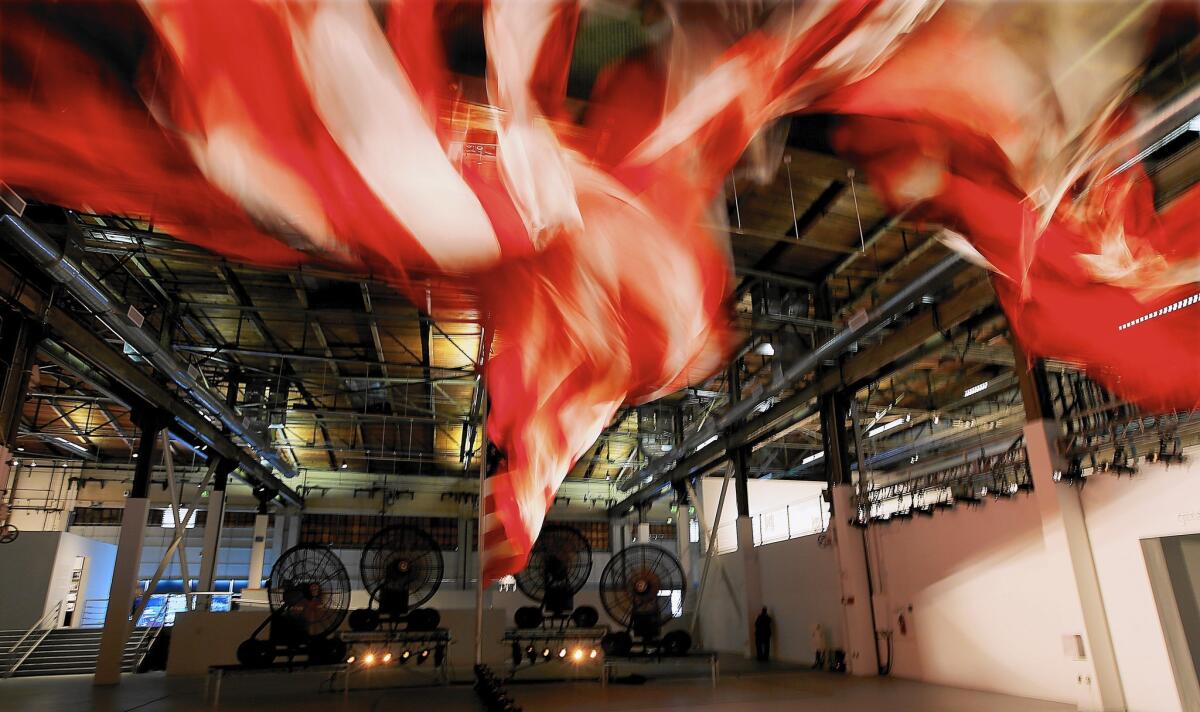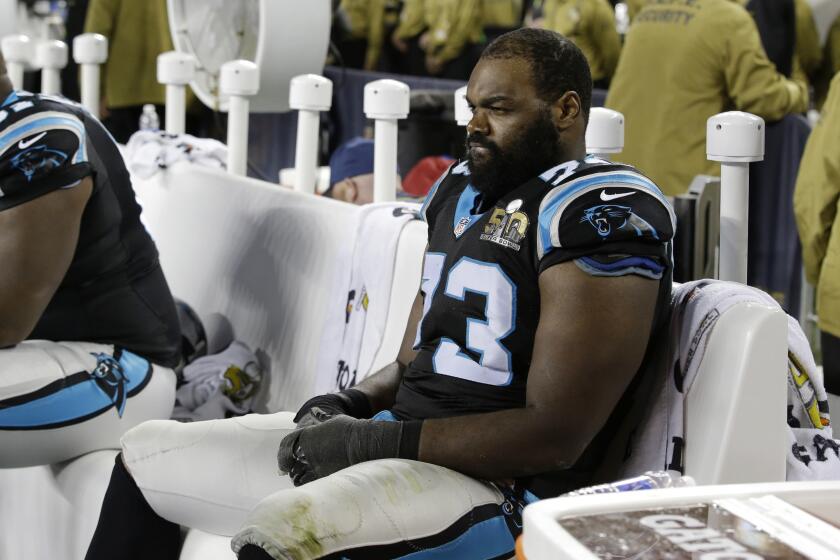Review: William Pope.L sets the U.S. flag waving at the MOCA/Geffen

In the spring of 2008, months before distracted voters focused on the fall presidential election, several TV reporters ginned up a fake campaign controversy to fill some airtime in the insatiable maw of the 24-hour news cycle.
The economy had collapsed, blood still gushed like oil in Iraq. Why, the digital Fourth Estate demanded to know, wasn’t the African American senator from Illinois, Barack Obama, wearing an American flag lapel-pin 24/7?
The candidate’s eventual opponent, John McCain, the white senator from Arizona, wasn’t wearing a flag pin at all times either. But only Obama’s patriotism was debated by the chattering class. Racial coding, unwitting or intentional, was underway, questioning whether the future president was “one of us.”
“Trinket” is a monumental 2008 installation sculpture by Newark-born, Chicago-based artist William Pope.L, 59, that put the disheartening display of media-mad political theater into devastating perspective. Centered on Old Glory, its title references the lapel pin.
First shown at Grand Arts, a project space in Kansas City, Mo., just weeks before election day, it has now gone on view at the Museum of Contemporary Art’s sprawling Geffen warehouse in Little Tokyo. Nearly seven years on, the sculpture still resonates.
That’s not because it harrumphs over abuse of the United States Code regarding flag etiquette — Chapter 1, Title 4, Section 8 (i) — which states that “the flag should never be used for advertising purposes in any manner whatsoever.” It doesn’t. Pope.L is an artist, not a nitpicking pedant.
It resonates deeply, disturbingly and, it should be noted, also enthusiastically. Pope.L takes democratic promise seriously, this sculpture affirms, and he knows as well as anyone that Obama went on to a decisive, 10-million vote election victory. His sculpture is multidimensional — like America itself — not a monolithic polemic.
“Trinket” is immense. The flag is 16 feet tall, 45 feet long and affixed to a sturdy aluminum pole rising from floor to ceiling.
It made me smile. The huge size is a witty representation of the vastness to which modern media’s magnifying lens inflated the ludicrous lapel-pin hullabaloo.
Pope.L dramatizes the spectacle. (Theater is his specialty.) Four big industrial fans, the special-effects type used in Hollywood to create phony cinematic storms, are positioned near the flagpole.
When the fans rev up, the forceful wind lifts the Stars and Stripes and sends the banner billowing. A loud and steady rumble issues from the gale. Banks of klieg lights are sequentially programmed, further cranking up the pageantry.
From the sides, the billowing flag is an awesome sight. Rippling, roaring, flashing — it’s a thrilling, enveloping spectacle.
Walk around behind the whirling fans, however, maintaining your distance from the fiercely spinning blades, and the feeling becomes more sinister. The modern mechanisms of display expose themselves as industrial-strength hocus-pocus. This really is dangerous.
Then, when you hike down to the flag’s other end, 45 feet away, the wind whipping through your hair almost as furiously as it does through the Stars and Stripes, the experience shifts again. You can feel as if you’ve been caught up in a disorienting tempest. “Trinket” isn’t so benign after all.
The stirring sculpture is a media-age abstraction. Nonetheless, it possesses all the vivid fervor of Delacroix’s famous figurative painting of “Liberty Leading the People,” the flag-waving ode to populist emancipation in 19th century France.
“Trinket” is technically complex but visually straightforward. It stages a variety of mechanisms that manipulate imagery. Once seen, they’re unforgettable.
The egalitarian promise of the flag’s symbolism is easily acknowledged, but what makes the sculpture great is its layered depth. More difficult to represent is the symbol’s power, whose source is counterintuitive: The symbol is dynamic because its egalitarian promise has not been fulfilled.
It never can be. Perfection is not ours to claim. Struggle carries on. The promise isn’t dead; it’s very much alive.
Or, as the U.S. Code also declares: “The flag represents a living country and is itself considered a living thing.” Jingoism is inert, so this big flag sets it aside.
Pope.L added a 51st star to the 50 on the flag. Think of the extra star as representing a state of mind, not territory. Expanding liberation is integral to the national fabric.
Rousing celebration also coexists with darker, less festive thoughts. The stripes, for instance, are not completely sewn together at the end of the flag. A uniform emblem unravels into disarray.
The flapping red and white banner-strips look like the ones on jaunty advertising balloons attached to motorized blower-fans, which beckon wildly at used-car lots or mattress stores. Commercial consumption rears its head. An implied privatization of public ideals is not pretty.
Inescapable is the disparity between the flag’s scale, which dwarfs anyone in its vicinity, and the trifle implied by a trinket. Monumentality became a norm in American sculpture in the 1960s, but here it threatens to crush us if we don’t take care.
Pope.L is perhaps best known for performance works like “The Great White Way.” In short segments spread out over nine years, he crawled 22 miles on his stomach from one end of Broadway in Manhattan to the other, wearing a Superman outfit with a skateboard strapped to his back where the cape should be.
Endurance works by performance artist Chris Burden, who in 1973 crawled bare-chested through a nighttime field of broken glass in downtown L.A., are one precedent for Pope.L’s work. So is Charles Ray, whose nearly invisible 1988 sculpture of a spinning white disk embedded flush into a white wall is evoked by a second Pope.L sculpture at the Geffen: “Blind” is a framed black square on a white wall that, upon closer inspection, turns out to be a black hole. A stiff breeze blows through.
MOCA curator Bennett Simpson, who organized the show, added a handful of works. Partly they provide additional context to illuminate the flag piece, and partly they serve the pragmatic need to fill available gallery space. But none is as arresting as “Trinket.”
One features live people, their faces shrouded behind Methuselah-style white wigs, clambering in slow-motion over white fences. Another arrays tabletop fields of onions, each painted like a fishing bob or semaphore and sprouting greens — new life — as it shrivels in decay.
A third is a viewing stand. You climb up and then peer down into a deep square well: A dizzying video-kaleidoscope, made with mirrors, swirls at the bottom.
Another video centers on a disintegrating model of the U.S. Capitol dome, crowned by Thomas Crawford’s Civil War-era “Statue of Freedom” — a bronze sculpture whose complex casting was ironically, cruelly performed by Philip Reid, a foundry slave. Chickens peck and goats munch on it in a fairly obvious image of our congressional barnyard.
A four-hour video called “Reenactor” is based on Civil War reenactment games. People go about their daily routines while comically, sadly dressed up as Confederate Gen. Robert E. Lee.
The presence of the past, heroic or barbarous, is a given. But it’s more eloquently — and concisely — conveyed in the mighty “Trinket.”
-----------------------
‘Trinket’
Where: Geffen Contemporary at MOCA, 152 N. Central Ave., Little Tokyo
When: Through June 28. Closed Tuesdays and Wednesdays.
Info: (213) 626-6222, https://www.moca.org
More to Read
The biggest entertainment stories
Get our big stories about Hollywood, film, television, music, arts, culture and more right in your inbox as soon as they publish.
You may occasionally receive promotional content from the Los Angeles Times.











